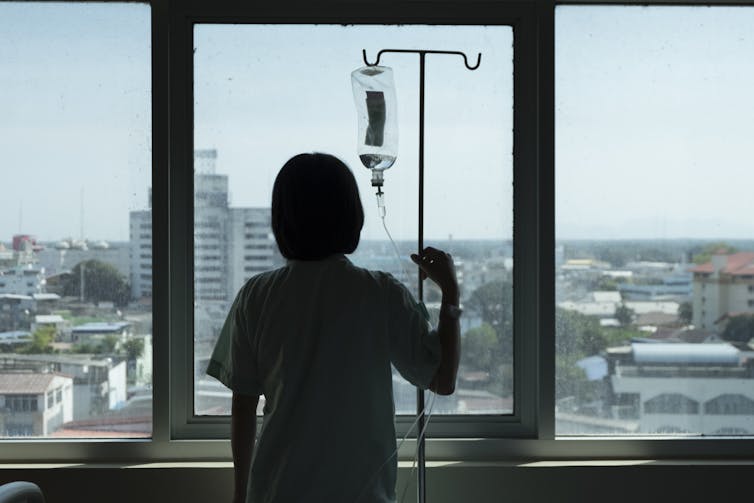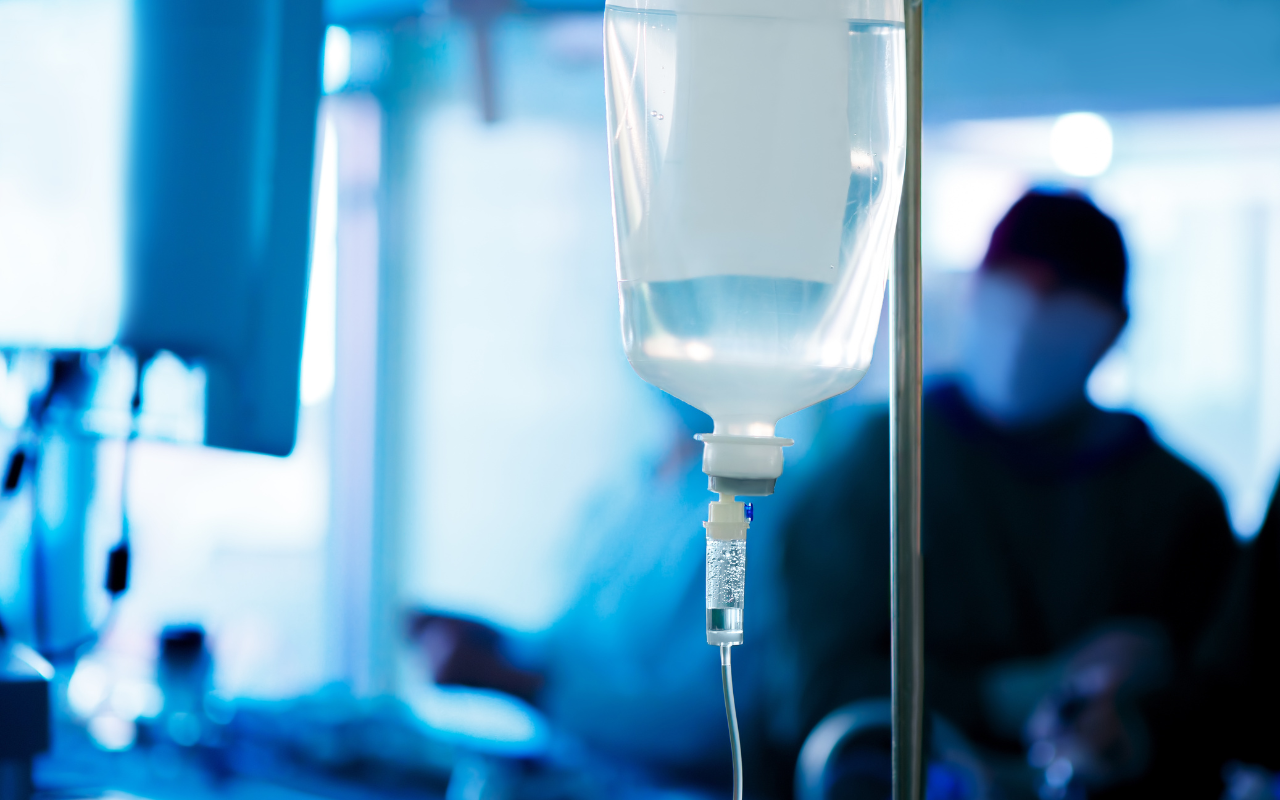Last week, the Australian Therapeutic Goods Administration added intravenous (IV) fluids to the growing list of medicines in short supply. The shortage is due to higher-than-expected demand and manufacturing issues.
Two particular IV fluids are affected: saline and compound sodium lactate (also called Hartmann’s solution). Both fluids are made with salts.
There are IV fluids that use other components, such as sugar, rather than salt. But instead of switching patients to those fluids, the government has chosen to approve salt-based solutions by other overseas brands.
So why do IV fluids contain different chemicals? And why can’t they just be interchanged when one runs low?
We can’t just inject water into a vein
Drugs are always injected into veins in a water-based solution. But we can’t do this with pure water, we need to add other chemicals. That’s because of a scientific principle called osmosis.
Osmosis occurs when water moves rapidly in and out of the cells in the blood stream, in response to changes to the concentration of chemicals dissolved in the blood plasma. Think salts, sugars, nutrients, drugs and proteins.
Too high a concentration of chemicals and protein in your blood stream leads it to being in a “hypertonic” state, which causes your blood cells to shrink. Not enough chemicals and proteins in your blood stream causes your blood cells to expand. Just the right amount is called “isotonic”.
Mixing the drug with the right amount of chemicals, via an injection or infusion, ensures the concentration inside the syringe or IV bag remains close to isotonic.

What are the different types of IV fluids?
There are a range of IV fluids available to administer drugs. The two most popular are:
- 0.9% saline, which is an isotonic solution of table salt. This is one of the IV fluids in short supply
- a 5% solution of the sugar glucose/dextrose. This fluid is not in short supply.
There are also IV fluids that combine both saline and glucose, and IV fluids that have other salts:
- Ringer’s solution is an IV fluid which has sodium, potassium and calcium salts
- Plasma-Lyte has different sodium salts, as well as magnesium
- Hartmann’s solution (compound sodium lactate) contains a range of different salts. It is generally used to treat a condition called metabolic acidosis, where patients have increased acid in their blood stream. This is in short supply.
What if you use the wrong solution?
Some drugs are only stable in specific IV fluids, for instance, only in salt-based IV fluids or only in glucose.
Putting a drug into the wrong IV fluid can potentially cause the drug to “crash out” of the solution, meaning patients won’t get the full dose.
Or it could cause the drug to decompose: not only will it not work, but it could also cause serious side effects.
An example of where a drug can be transformed into something toxic is the cancer chemotherapy drug cisplatin. When administered in saline it is safe, but administration in pure glucose can cause life-threatening damage to a patients’ kidneys.
What can hospitals use instead?
The IV fluids in short supply are saline and Hartmann’s solution. They are provided by three approved Australian suppliers: Baxter Healthcare, B.Braun and Fresenius Kabi.
The government’s solution to this is to approve multiple overseas-registered alternative saline brands, which they are allowed to do under current legislation without it going through the normal Australian quality checks and approval process. They will have received approval in their country of manufacture.
The government is taking this approach because it may not be effective or safe to formulate medicines that are meant to be in saline into different IV fluids. And we don’t have sufficient capacity to manufacture saline IV fluids here in Australia.
The Australian Society of Hospital Pharmacists provides guidance to other health staff about what drugs have to go with which IV fluids in their Australian Injectable Drugs Handbook. If there is a shortage of saline or Hartmann’s solution, and shipments of other overseas brands have not arrived, this guidance can be used to select another appropriate IV fluid.
Why don’t we make it locally?
The current shortage of IV fluids is just another example of the problems Australia faces when it is almost completely reliant on its critical medicines from overseas manufacturers.
Fortunately, we have workarounds to address the current shortage. But Australia is likely to face ongoing shortages, not only for IV fluids but for any medicines that we rely on overseas manufacturers to produce. Shortages like this put Australian lives at risk.
In the past both myself, and others, have called for the federal government to develop or back the development of medicines manufacturing in Australia. This could involve manufacturing off-patent medicines with an emphasis on those medicines most used in Australia.
Not only would this create stable, high technology jobs in Australia, it would also contribute to our economy and make us less susceptible to future global drug supply problems.
Nial Wheate is a professor and director of academic excellence at Macquarie University.
Shoohb Alassadi is a casual academic of pharmaceutical sciences at University of Sydney.
This article is republished from The Conversation under a Creative Commons license. Read the original article.
The statements or opinions expressed in this article reflect the views of the authors and do not necessarily represent the official policy of the AMA, the MJA or InSight+ unless so stated.
Subscribe to the free InSight+ weekly newsletter here. It is available to all readers, not just registered medical practitioners.
If you would like to submit an article for consideration, send a Word version to mjainsight-editor@ampco.com.au.

 more_vert
more_vert
Setting up IV fluid industries by guaranteeing local hospital quota purchases is by default forcing them to buy local and (almost certainly) far more expensive products which not only increases healthcare costs but also disincentivise competitive pricing by local players. This will lead to costs blowout and complacency by local manufacturers often owned by only a handful of players, sometimes even less.
Instead of this, the government should set out long term tenders for theseIV products limited to local manufacturers primarily for military use/deployment and foreign aid to pacific nations in healthcare products, which looks good for the government (the higher costs being reflected as higher monetary value of foreign aid) as well as reinforcing the origins of the aid by the products clearly labeled as “made in Australia “. I know that the last statement sounds mercenary and calculating which does not completely align with the nobility of giving to the needful but ultimately we are dealing with the psychological warfare in trying to win the hearts and minds in the region.
Nothing can beat those news image of trucks unloading relief aids labelled US aid or Made in the USA in war zones and disaster areas in my childhood in 1970s and 80s and Australia should take a leaf out of that strategy. They can package as much as they want in aid box clearly labelled Australia but once the box is decanted in home or hospitals, where the product is made is ultimately clearly seen on the product itself not the boxes
But trying to have special conditions to cater for local manufacturing in healthcare products is simply unsustainable and not economical sound.
A logical solution would be for legislation requiring all public hospitals to source say 10% of all consumables from a locally-made supplier. Masks/PPE, disposable drapes, drip fluids, off-patent drugs, needles, syringes etc. The larger capex items like beds, wheelchairs, furniture etc could also be considered.
A guaranteed market would make it worthwhile for local manufacturers either as a standalone, or as a local franchise of a global company (much as Coca Cola manufactures locally). Jobs and skills stay in Australia, manufacturing equipment is available to increase production (e.g. when COVID blocked our access to Chinese PPE imports) in times of need.
The local 10% would probably cost more than the imported 90%, given our expensive labour, transport, and power costs; but it would essentially be a government guarantee of supplies in times of shortage/disaster/conflict. Ministerial exemption could be exercised in a rare situation where it was unfeasible to manufacture locally (e.g. Covid mRNA vaccines), or low-volume items like MRI scanners.
It is about time we stopped being reliant on external manufacturers of any of our vital supplies. The current global political situation makes this even more urgent. We have stupidly rendered ourselves vulnerable to the whim of other countries and to geopolitical change. Imagine the consequences of a sudden and complete lack of IV fluids and antibiotics etc. in a routine domestic setting let alone a time of conflict.
Intravenous fluids can be made up in appropriate concentrations by adding calculated doses of salts from sterile ampoules of more concentrated salt solutions to appropriate volumes of sterile water.
This assumes there are adequate amounts of sterile water in appropriately sized volumes for intravenous administration eg 1 Litre of sterile water can be made into a litre of Normal Saline by adding 4.5 10 ml ampoules of 20% Saline to it.
Adding drugs to litres (or smaller volumes) of IV fluids is common in ICU and A&E.
This approach may also help alleviate the current shortage but local manufacture would be optimal
Regards Paul Burt